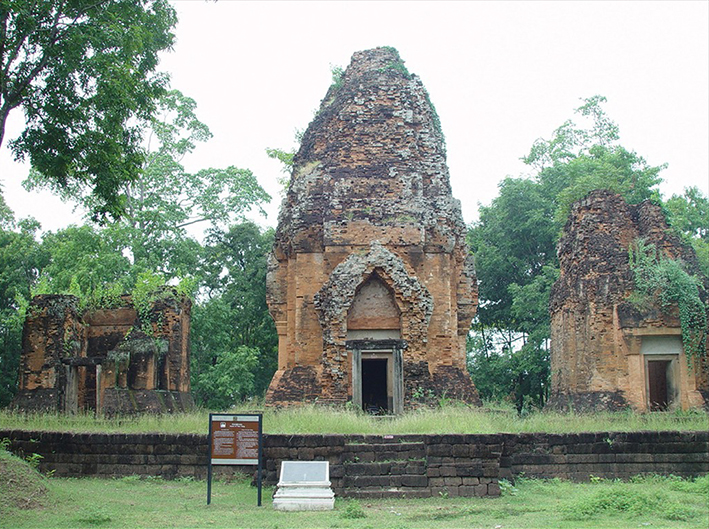Beliefs and Meanings in Architecture: Three Temple Towers in Northeastern Thailand
Main Article Content
Abstract
The three temple towers are a distinctive feature of ancient Khmer architecture, created to pay homage to Shiva, Vishnu, and Brahma (the Hindu Trimurti or Trinity). This architectural style was first developed in Angkor during the Kulen period in the 14th Buddhist century. The style gained popularity and evolved into community deity shrines in the northeastern region of Thailand during the 16th to 17th Buddhist centuries.
This article aims to explore the development of the design of three temple towers found in the northeastern region of Thailand from the 16th to the 18th Buddhist centuries. It examines the significance of architectural elements by comparing them with the step pyramid architectural forms. The article also discusses the changes in the architectural meaning of the three temple towers by studying various aspects, such as historical information, architectural styles, and religious beliefs, from case studies across different areas. This analysis seeks to interpret the concepts behind the architectural design of the three temple towers.
The study found that the three temple towers in the northeastern region of Thailand were constructed between the 16th and 17th Buddhist centuries as ceremonial centers for the community. The choice of the three temple towers as the community’s sacred site may stem from various reasons. Firstly, architectural dignity played a role, as most temples built in the capital city featured a multi-tiered base style exclusively reserved for royal institutions. This style symbolized governance, status, and the replication of the cosmic order, establishing a traditional concept of regality. As a result, the three temple towers were widely adopted by commoners with a lower status than royalty as ceremonial venues within their communities. Secondly, the simplicity of the three temple towers was a key factor. Its straightforward design, lacking the complexity of the multi-tiered base temples, made it easier and faster to construct, allowing for convenient construction in remote areas.
When the influence of Mahayana Buddhist beliefs began to reach northeastern Thailand around the 18th Buddhist century, the style was adapted to align with religious beliefs, transitioning from deity sanctuaries to fully-fledged Buddhist sites.
Downloads
Article Details

This work is licensed under a Creative Commons Attribution-NonCommercial-NoDerivatives 4.0 International License.
References
Anuvit Charernsupkul. Prāsāt Mư̄ ang Tam kānsưksā thāng prawattisāt sathāpattayakam [The Architectural Design of Prasat Muang Tam]. Bangkok: Faculty of Architecture, Silpakorn University, 1998.
Fine Arts Department. Thānānusak nai ngān sathāpattayakam Thai [Social Hierarchy in Thai Architecture]. Bangkok: Fine Arts Department, 2008.
Freeman, Michael, and Claude Jacques. Ancient Angkor. Bangkok: River Books Limited., 2007.
Petrotchenko, Michel. Focusing on the Angkor Temples: The Guidebook. 2nd ed. Bangkok: Amarin Printing and Publishing Co., Ltd., 2012.
Puranrak Limited Partnership. Rāingān kān khut tǣ - khut khon - būrana læ prapprung saphāp phū mi that bōrānnasathān Kū Nō̜ i Bān Dǣng tambon Nō̜ ng Sǣng ʻamphoē Wāpī Pathum čhangwat Mahā Sārakhām [Report on Archaeological Discoveries, Restoration, and Landscape Renovation of the Ku Noi Ban Dang Archaeological Site in Nong Saeng Sub-District, Wapi Pathum District, Maha Sarakham Province]. 2001.
Subhadradis Diskul. Sinlapa samai Lop Burī [Lopburi Art]. 3rd ed. Bangkok: Amarin Printing and Publishing Company Limited., 2004.
Vanvipha Suneta. Chai Wō̜ ra Man thī čhet : mahārāt ʻong sut thāi khō̜ ng ʻānāčhak Kamphūchā phū nēramit sathāpanā prāsāt Bā yon læ mư̄ ang Nakhō̜ n thom [Jayavarman VII: The Last Great King of the Kingdom of Cambodia who built the Bayon Temple and Angkor Thom]. Bangkok: Matichon, 2005.
Wiroj Sheewasukthaworn. “Kān sannitthān rūpbǣp sathāpattayakam klum prāsāt prathān prāsāt Pư̄ yō̜ Nō̜ i čhō̜ . Khō̜ n Kǣn [The Reconstruction of the Three Sanctuary Towers: Case Study of Prasat Pueai-Noi, Khon Kaen Province].” Built Environment Inquiry Journal, Faculty of Architecture, Khon Kaen University 17, 1 (January-June 2018): 1-21.
Wiroj Sheewasukthaworn. “Kān sannitthān rūpbǣp sathāpattayakam Kū Bān Dǣng čhangwat Mahā Sārakhām [Reconstruction of Architecture in Ku-Ban Dang Maha Sarakham Province].” Journal of Humanities and Social Sciences, Maha Sarakham University 28, 1 (January-March 2009): 40-56.
Wiroj Sheewasukthaworn. Prawattisāt Sathāpattayakam Thai phatthanākān nǣo khwāmkhit læ kān khlī khlāi rūpbǣp [History of Thai Architecture: Evolution of Ideas and Styles]. Khon Kaen: Pen Printing, 2018.
Witchu Vejjajiva. Naklā prāsāt thī eo bōrān khō̜ m nō̜ k mư̄ ang Phra Nakhō̜ n [Prasat Explorers: Exploring Ancient Khmer Beyond the Capital City]. Bangkok: Muangboran, 2006.


